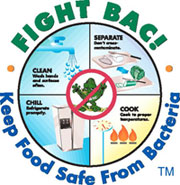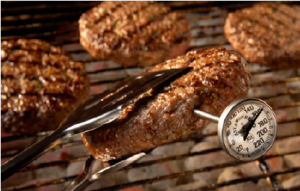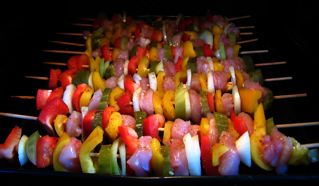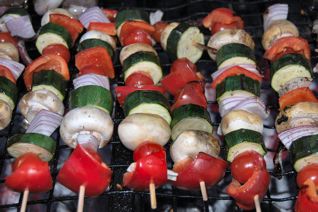 Everyone knows how important Food Safety is when it comes to summertime cookouts.
Everyone knows how important Food Safety is when it comes to summertime cookouts.
The “Fight Bac!™” program of The Partnership for Food Safety Education has provided lots of pertinent information to help everyone think ahead about how to reduce their risk of foodborne illness. This is especially true when it comes to warm weather food preparation and eating food items from summertime cookouts either outdoors or indoors.
Image for “Keep Food Safe From Bacteria” courtesy of the Fight Bac!™ program.
Follow sound, proper pre-preparation & safe cooking advice when it comes to food items as provided by USDA via their convenient fact sheets or searchable food safety education site. Putting into practice their practical materials concerning food purchasing, transportation & pre- as well as post-cooking storage, along with cooking caveats and then adhering to the four main Fight Bac!™ or Home Food Safety™ steps of:
- Clean/Wash,
- Separate,
- Cook to proper temperature, &
- Chill/Refrigerate any leftover food items promptly & properly can really make a significant difference when it comes to food safety.
You can download a BBQ food safety handout from USDA that will remind you of these many important considerations so that you can more safely enjoy your summertime cooking & entertaining.
This approach also ties into the ongoing series over the past two months on this blog site dealing with Beyond Watchful Waiting (Food, Nutrition & Prostate Cancer). Remember that the following only qualifies as infotainment and that you should seek advice personalized for your own health needs from your own health care practitioners.
When it comes to the “cook” step for “meats”, one should avoid overcooking lean “meats” per se, which include lean beef, fish, pork, or poultry, at very high temperatures either via pan frying or grilling over an open flame as that practice has been shown in laboratory studies to lead to the production of carcinogenic heterocyclic amines (HCAs), one of which is PhIP, known to promote prostate cancer in animal studies when very high doses of it were ingested.
HCAs are formed when the nitrogen containing amino acids, the building blocks of the proteins in the “meats” themselves, along with sugars and creatine (another muscle protein) react at high temperatures (some studies cite at least 300°F, while other studies cite closer to 400°F).
If “meat” is being exposed to a high temperature cooking surface, turning it over frequently might help to reduce HCAs formation risk and thus be more desirable than just turning it over once.
 Ground meat that is fried or grilled has thus far been shown to have the greatest potential for developing such HCAs.
Ground meat that is fried or grilled has thus far been shown to have the greatest potential for developing such HCAs.
Image of ground beef patty with analog read thermometer in it showing the meat patty has reached the doneness temperature of 160°F for Food Safety purposes courtesy of the Teach Free site. (There are other newer styles of thermometers out there to check for beef patty doneness including digital read thermometers). Feel free to check out the Teach Free site funded by the Beef Checkoff, which provides the publication “Basics About Beef” and more for additional useful details about beef.
The recommendations overall have been to avoid “well done” longer cooking of “meats” which can easily include typical outdoor BBQing. Meats need to be cooked adequately for food safety, but not overdone.
To avoid over-cooking intact “meat” on an outdoor BBQ grill, one can look for recipes that allow one to pre-cook any “meat” item including chicken or beef by first microwaving it until partially done or possibly pre-cooking it via boiling, braising, poaching, steaming, or stewing as feasible prior to placing the food item on the grill, as you want the least grilling contact time possible.
An indoor slow cooker preparation of “meat” combined with use of a judicious BBQ type sauce can sometimes substitute more safely for actual BBQing.
Another option is to prepare “meat” items on a wood safe plank (for example, appropriate cedar) on top of the grill surface so that there is not direct contact of the “meat” item with any outdoor grill flames.
Another suggestion is to prepare items for the grill, but to then place them on a sheet of aluminum foil dull side up so that no grill flames can reach the items (using an example of a BBQ skewer) as noted by a suggestion for a Healthy BBQ plate.
Similarly, one should avoid charbroiling red meat or chicken, with its skin intact, as that leads to the production of carcinogenic polycyclic aromatic hydrocarbons (PAHs).
 PAHs are formed when any melting fat and/or juices from “meat” cooking over an open flame drip down onto the fire source, causing flame flare-ups. The flames now contain PAHs which can stick to the surface of the grilling “meat” per se. Barbecue image courtesy of Vorfay at rgbstock.com.
PAHs are formed when any melting fat and/or juices from “meat” cooking over an open flame drip down onto the fire source, causing flame flare-ups. The flames now contain PAHs which can stick to the surface of the grilling “meat” per se. Barbecue image courtesy of Vorfay at rgbstock.com.

PAHs are also produced during other cooking methods such as when smoking “meats” per se, as well as when other food items are charred per se (think of grilled kebabs where sometimes the skewered vegetables are charred).
Vegetable skewers image courtesy of sloopjohnb at rgbstock.com.
PAHs have also been found to exist in cigarette smoke as well as in car exhaust fumes.
Although there have not been specific recommendations in the literature when it comes to levels of HCAs and PAHs exposure to avoid, to reduce one’s overall HCAs & PAHs exposure, avoid consuming charred food items and also limit use of meat drippings per se if high temps for meat preparation were involved.
It has also been suggested in some studies that the use of herbs and spices such as fingerroot, rosemary and turmeric may block the formation of some HCAs when “meat” items are BBQ’d, broiled, fried, or grilled. Similarly it has been postulated that the use of a marinade rich in anti-oxidant herbs including carvacrol-rich oregano infused EVOO in the “meat” preparation may also help to inhibit the formation of HCAs.
It should be noted that both HCAs and PAHs go through bioactivation in the body (involving metabolism by specific enzymes) which might explain how their risk can vary for each individual since the activity of the enzymes varies among individuals. Nonetheless, a number of epidemiological studies have showed a correlation between high consumption of well-done, fried, or BBQ’d meats and increased risk of developing a number of cancers, including colorectal, pancreatic, and prostate cancers.
General recommendations in the literature are to keep lean meat portions smaller than an average woman’s palm size. For poultry, remove any visible skin and trim off excess fat prior to eating.
By following some of the above suggestions and also checking out the Fight Bac!™ and related websites (including the University of Nebraska-Lincoln Extension site publication on “Grill It Safely!”) , it is still possible to enjoy your summertime cookouts, while not only keeping your food safe from foodborne illness, but also potentially helping you to reduce your overall risk of developing certain cancers.

